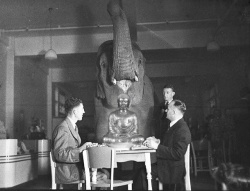Difference between revisions of "The Four Gatherings : Benefits of Tsok Practice"
m (Text replacement - "meat" to "meat") |
|||
| (One intermediate revision by one other user not shown) | |||
| Line 1: | Line 1: | ||
| − | {{DisplayImages|2426|2559|3596|2070 | + | {{DisplayImages|2426|2559|3596|2070}} |
<poem> | <poem> | ||
| − | The teachings explain that '[[tsok]]' refers to four different types of | + | The teachings explain that '[[tsok]]' refers to [[four different types of gathering]], those of: |
1. practitioners, | 1. practitioners, | ||
| Line 10: | Line 10: | ||
1. The [[Gathering of Practitioners]] | 1. The [[Gathering of Practitioners]] | ||
| − | In the teachings this is known as the '[[gathering]] of [[fortunate]] {{Wiki|individuals}}' because only [[beings]] with the greatest good [[fortune]] can meet and practise the [[Vajrayana]] [[path]]. The {{Wiki|male}} and {{Wiki|female}} [[tantric practitioners]] [[gather]] together to celebrate the [[tsok]] | + | In the teachings this is known as the '[[gathering]] of [[fortunate]] {{Wiki|individuals}}' because only [[beings]] with the greatest good [[fortune]] can meet and practise the [[Vajrayana]] [[path]]. The {{Wiki|male}} and {{Wiki|female}} [[tantric practitioners]] [[gather]] together to celebrate the [[tsok feast]] on the tenth day of the waxing [[moon]] and the tenth day of the waning [[moon]], as well as on special anniversaries in the [[Buddhist]] [[calendar]]. |
[[Tsok]] can also be [[offered]] in [[gratitude]] whenever we gain [[signs]] of [[accomplishment]] in our practice, or for [[purification]] whenever [[signs]] of an {{Wiki|impairment}} or breakage of [[samaya]] occur. | [[Tsok]] can also be [[offered]] in [[gratitude]] whenever we gain [[signs]] of [[accomplishment]] in our practice, or for [[purification]] whenever [[signs]] of an {{Wiki|impairment}} or breakage of [[samaya]] occur. | ||
| − | An important part of the practice is [[pure perception]], so everyone is viewed according to his or her [[enlightened]] nature—all the {{Wiki|male}} practitioners as [[dakas]] who embody [[skilful means]], and all the {{Wiki|female}} practitioners as [[dakinis]], who are the embodiments of | + | An important part of the practice is [[pure perception]], so everyone is viewed according to his or her [[enlightened]] nature—all the {{Wiki|male}} practitioners as [[dakas]] who embody [[skilful means]], and all the {{Wiki|female}} practitioners as [[dakinis]], who are the [[embodiments of wisdom]]. |
It is said in the [[tantras]] that the {{Wiki|male}} practitioners should sit on the right and the females on the left, facing each other, with the [[Vajra Master]] in the centre and facing the assembly. Practitioners should wear their best [[clothes]] to provide an [[auspicious]] connection for the [[accumulation of merit]]. | It is said in the [[tantras]] that the {{Wiki|male}} practitioners should sit on the right and the females on the left, facing each other, with the [[Vajra Master]] in the centre and facing the assembly. Practitioners should wear their best [[clothes]] to provide an [[auspicious]] connection for the [[accumulation of merit]]. | ||
| Line 22: | Line 22: | ||
It is best to have an {{Wiki|equal}} number of {{Wiki|male}} and {{Wiki|female}} practitioners, as this [[symbolizes]] the balancing of [[skilful means]] and [[wisdom]]. | It is best to have an {{Wiki|equal}} number of {{Wiki|male}} and {{Wiki|female}} practitioners, as this [[symbolizes]] the balancing of [[skilful means]] and [[wisdom]]. | ||
| − | We should consider the place where we [[gather]] not as an ordinary room or building, but as the [[sacred]] place where [[Guru Rinpoche]] himself | + | We should consider the place where we [[gather]] not as an ordinary room or building, but as the [[sacred]] place where [[Guru Rinpoche]] himself practices the [[tsok feast]], in the company of [[infinite]] [[dakas]] and [[dakinis]]. |
2. The [[Gathering of Offering Substances]] | 2. The [[Gathering of Offering Substances]] | ||
| − | This is [[traditionally]] referred to as the [[gathering | + | This is [[traditionally]] referred to as the [[gathering of 'delightful substances]].' |
| − | It refers to the [[food]] and drink that will be [[offered]] by the practitioners during the practice. It is said that the edible {{Wiki|substances}} represent [[skilful means]] and the liquids represent [[wisdom]]. It is important that the [[offering]] includes many different {{Wiki|substances}}, especially, it says in the [[tantras]], | + | It refers to the [[food]] and drink that will be [[offered]] by the practitioners during the practice. It is said that the edible {{Wiki|substances}} represent [[skilful means]] and the liquids represent [[wisdom]]. It is important that the [[offering]] includes many different {{Wiki|substances}}, especially, it says in the [[tantras]], meat and [[alcohol]]. |
The teachings also [[stress]] that we should be generous in our [[offerings]], and not offer just a little amount with a miserly [[attitude]]. We should try to avoid polluting the [[offerings]] with limited [[dualistic]] [[Wikipedia:concept|concepts]], by [[thinking]] something is too good or too expensive to offer, or even that something is too dirty or impure, or only [[offering]] things we like ourselves and leaving out all the things we don't like. | The teachings also [[stress]] that we should be generous in our [[offerings]], and not offer just a little amount with a miserly [[attitude]]. We should try to avoid polluting the [[offerings]] with limited [[dualistic]] [[Wikipedia:concept|concepts]], by [[thinking]] something is too good or too expensive to offer, or even that something is too dirty or impure, or only [[offering]] things we like ourselves and leaving out all the things we don't like. | ||
| Line 36: | Line 36: | ||
3. The [[Gathering of Deities]] | 3. The [[Gathering of Deities]] | ||
| − | This is [[traditionally]] called 'the [[gathering | + | This is [[traditionally]] called 'the [[gathering of deities]] who are the source of accomplishments.' The [[word]] '[[gathering]]' {{Wiki|signifies}} that we are not just [[offering]] to a single [[deity]], but to an entire [[mandala]], or even several [[mandalas]] of [[deities]], each consisting of the [[principal]] [[deity]] together with the retinue. It is important that we have some image—a statue, a [[thangka painting]] or a photograph of the [[mandala]] or of our own [[root]] master—whenever we offer [[tsok]], as a support for the practice. |
4. The [[Gathering of Merit and Wisdom]] | 4. The [[Gathering of Merit and Wisdom]] | ||
Latest revision as of 13:55, 30 December 2014
The teachings explain that 'tsok' refers to four different types of gathering, those of:
1. practitioners,
2. offering substances,
3. deities, and
4. merit and wisdom.
1. The Gathering of Practitioners
In the teachings this is known as the 'gathering of fortunate individuals' because only beings with the greatest good fortune can meet and practise the Vajrayana path. The male and female tantric practitioners gather together to celebrate the tsok feast on the tenth day of the waxing moon and the tenth day of the waning moon, as well as on special anniversaries in the Buddhist calendar.
Tsok can also be offered in gratitude whenever we gain signs of accomplishment in our practice, or for purification whenever signs of an impairment or breakage of samaya occur.
An important part of the practice is pure perception, so everyone is viewed according to his or her enlightened nature—all the male practitioners as dakas who embody skilful means, and all the female practitioners as dakinis, who are the embodiments of wisdom.
It is said in the tantras that the male practitioners should sit on the right and the females on the left, facing each other, with the Vajra Master in the centre and facing the assembly. Practitioners should wear their best clothes to provide an auspicious connection for the accumulation of merit.
Some masters say the practitioners should sit in order of seniority, according to when they first received empowerment into the Vajrayana, or according to their levels of experience and realization and their qualities as a practitioner.
It is best to have an equal number of male and female practitioners, as this symbolizes the balancing of skilful means and wisdom.
We should consider the place where we gather not as an ordinary room or building, but as the sacred place where Guru Rinpoche himself practices the tsok feast, in the company of infinite dakas and dakinis.
2. The Gathering of Offering Substances
This is traditionally referred to as the gathering of 'delightful substances.'
It refers to the food and drink that will be offered by the practitioners during the practice. It is said that the edible substances represent skilful means and the liquids represent wisdom. It is important that the offering includes many different substances, especially, it says in the tantras, meat and alcohol.
The teachings also stress that we should be generous in our offerings, and not offer just a little amount with a miserly attitude. We should try to avoid polluting the offerings with limited dualistic concepts, by thinking something is too good or too expensive to offer, or even that something is too dirty or impure, or only offering things we like ourselves and leaving out all the things we don't like.
It is important that we consider the substances as offerings, and not as ordinary food and drink. To anticipate eating or drinking the tsok is what it says in the practice of Narak Kong Shak is '[[tsok wolf' behaviour. Kyabjé Dilgo Khyentse Rinpoche would say that this also includes bringing cups and plates together with the offerings, which shows one is already thinking about consuming them.
3. The Gathering of Deities
This is traditionally called 'the gathering of deities who are the source of accomplishments.' The word 'gathering' signifies that we are not just offering to a single deity, but to an entire mandala, or even several mandalas of deities, each consisting of the principal deity together with the retinue. It is important that we have some image—a statue, a thangka painting or a photograph of the mandala or of our own root master—whenever we offer tsok, as a support for the practice.
4. The Gathering of Merit and Wisdom
The final gathering is the result of the first three. The practice of tsok is a very powerful method for accumulating merit and wisdom.
The definitions of merit vary, but in simple terms we can think of the practices for accumulating merit as being the more conceptual aspects of the practice—visualization, generating devotion and compassion, offering, confessing and so on—and the practices for accumulating wisdom are the more non-conceptual aspects, such as the dissolution of the visualization.
On a deeper level, we accumulate merit by not grasping at anything during the practice, and we accumulate wisdom by remaining with non-conceptual reference.
The Benefits of Tsok Practice
The main benefit of tsok practice mentioned in the tantras is the accumulation of merit with conceptual focus as well as the accumulation of wisdom beyond focus. There could be no greater benefit than this.
In the termas, we also find mention of unimaginable benefits. For example, it is said that Guru Rinpoche himself will come and bless the tsok practitioners, or that the place where tsok is performed will become exactly the same as the Zangdokpalri heaven of Guru Rinpoche. And Yeshé Tsogyal said that to practice tsok just once closes the door to lower rebirths. It is also said that disease, famine and warfare will be pacified, and all the practitioners' wishes will be fulfilled without the slightest obstacle.



